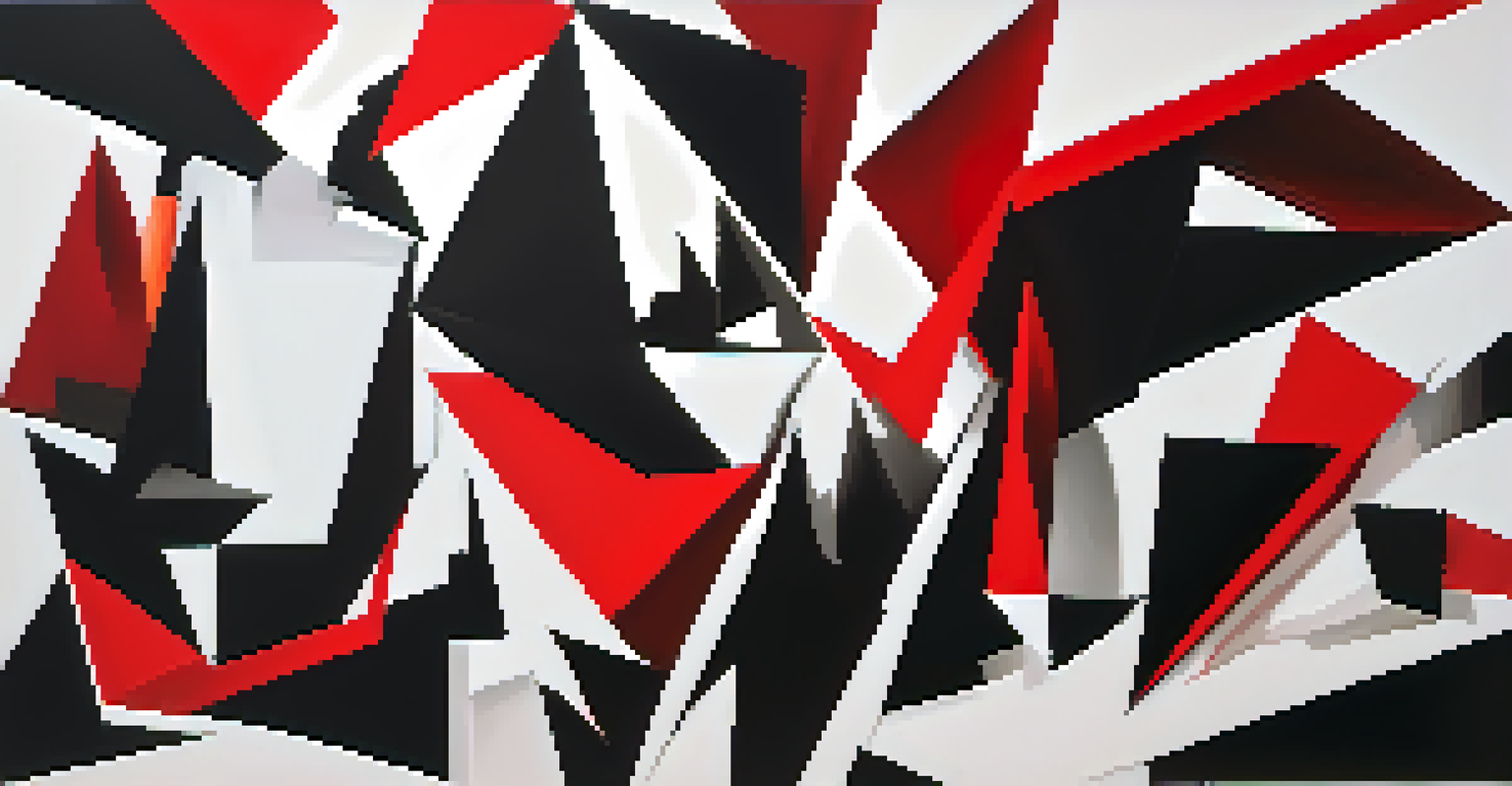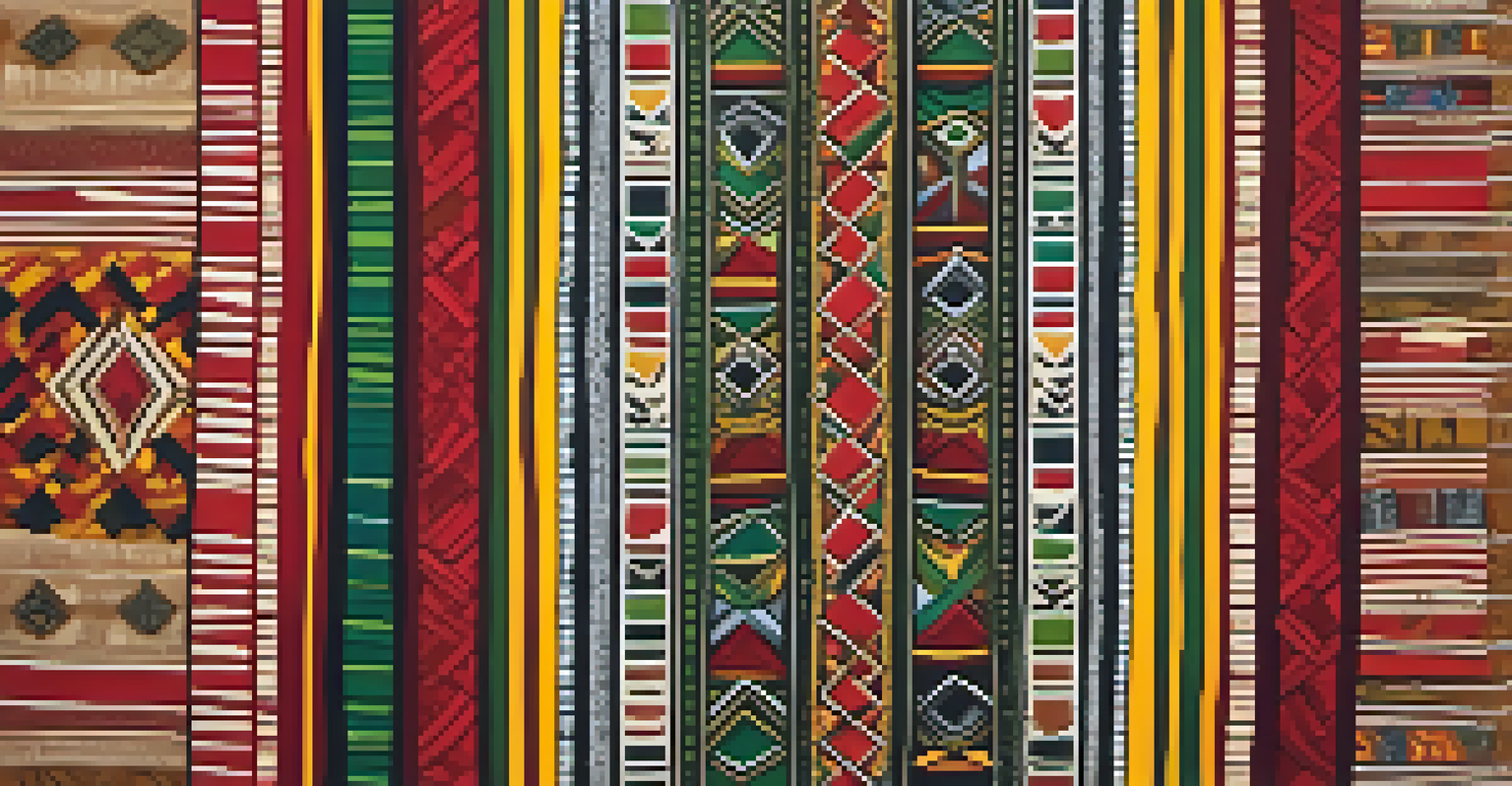The Interplay Between Color and Form in Artistic Design

Understanding the Basics of Color and Form in Art
Color and form are fundamental elements in artistic design, each playing a crucial role in how we perceive art. Color refers to the hues we see, which can evoke emotions and set the mood of a piece. Form, on the other hand, pertains to the shapes and structures that make up the artwork, guiding our eyes and thoughts. Together, they create a dynamic interplay that can transform a simple image into a compelling narrative.
Color is the keyboard, the eyes are the harmonies, the soul is the piano with many strings.
Imagine walking into a gallery filled with vibrant paintings. The bright reds and yellows may energize the space, while softer blues and greens can provide a calming effect. This emotional response is largely due to the colors chosen by the artist, which interact with the forms they depict. For instance, a swirling, abstract form combined with bold colors can create a sense of movement and excitement, drawing viewers in.
Ultimately, understanding how color and form work together is essential for both artists and art lovers. By analyzing the relationship between these elements, we can deepen our appreciation for the intentions behind a piece. This foundation sets the stage for exploring more complex interactions in artistic design.
The Emotional Impact of Color on Artistic Expression
Colors carry psychological weight and can evoke specific feelings. For instance, warm colors like red and orange often signify passion and energy, while cool colors like blue and green convey tranquility and calm. Artists leverage these emotional responses to guide viewers' reactions and interpretations of their work. A piece painted in fiery reds might feel aggressive, while one highlighted with soft pastels may seem delicate and soothing.

Consider how a sunset painting, filled with vibrant oranges and deep purples, can elicit feelings of warmth and nostalgia. This emotional response is a direct result of the color palette chosen by the artist. On the flip side, a monochromatic piece in shades of grey might evoke a sense of melancholy or introspection, illustrating the power of color in shaping our experiences with art.
Color Evokes Emotion in Art
Artists use color strategically to evoke specific emotions and influence viewers' interpretations.
By understanding the emotional impact of color, artists can intentionally design their work to resonate with viewers on a deeper level. This strategic use of color not only enhances the visual appeal but also enriches the narrative being told through the artwork.
How Form Influences Perception in Artistic Design
Form plays a vital role in the way we perceive art. The shapes and structures within a piece guide our eyes and can create a sense of movement or stability. For example, sharp angles may suggest tension, while rounded forms can evoke softness and comfort. This manipulation of form helps artists communicate their intended message effectively.
Form follows function—that has been misunderstood. Form and function should be one, joined in a spiritual union.
Take a moment to visualize a sculpture with sharp, jagged edges versus one with smooth, flowing lines. The former might feel aggressive or chaotic, while the latter appears inviting and peaceful. Such contrasts in form not only impact our emotional response but also influence how we engage with the artwork on a cognitive level.
As we explore the relationship between form and perception, it becomes clear that artists must carefully consider how their choices will affect viewer interpretation. Balancing form and color allows for a more cohesive and persuasive artistic statement.
The Synergy of Color and Form in Composition
The synergy between color and form is critical in creating a harmonious composition. When artists thoughtfully combine these elements, they can achieve balance and unity in their work. For example, a vibrant color might be paired with a contrasting form to create visual interest, drawing attention to a focal point. This strategic interplay enhances the overall impact of the piece.
Consider a landscape painting where the lush greens of the trees contrast with the stark, jagged mountains in the background. The colors not only differentiate the elements but also guide our eyes across the canvas. By using color and form together, the artist creates a narrative that flows seamlessly, inviting the viewer to explore every detail.
Form Guides Perception
The shapes and structures in artwork shape our perception, impacting emotional responses and cognitive engagement.
Ultimately, mastering the balance between color and form is key to successful artistic design. This synergy not only engages the audience but also elevates the artwork, making it more memorable and impactful.
Cultural Significance of Color and Form in Art
Color and form often carry cultural significance, influencing how art is created and interpreted across different societies. For instance, certain colors may hold specific meanings in various cultures; red might symbolize luck in China, while in Western cultures, it can represent love or danger. Similarly, forms can have cultural connotations, such as geometric shapes in Islamic art, which reflect a different aesthetic and spiritual approach.
An example can be seen in traditional African textiles, where vibrant colors and bold patterns tell stories of heritage and community. The interplay of color and form in these designs is not merely aesthetic; it serves a deeper purpose, connecting the artwork to its cultural roots. This awareness of cultural significance allows artists to communicate complex themes and messages through their work.
Understanding the cultural context of color and form enriches our appreciation of art and its diverse expressions. It encourages us to consider how these elements can transcend mere aesthetics to convey powerful narratives reflective of human experiences.
Practical Applications in Modern Artistic Design
In contemporary artistic practice, the interplay of color and form is increasingly relevant, especially in fields like graphic design and advertising. Designers utilize color theory to evoke specific emotions and guide consumer behavior. For instance, a brand might use vibrant colors to attract attention, while softer hues can create a sense of trust and reliability.
Consider how a website's color scheme can influence user experience. Bright colors can create excitement and urgency, encouraging visitors to take action, while muted tones can foster a calm browsing experience. This understanding of how color and form affect perception is essential for effective design in today's digital landscape.
Cultural Context Shapes Meaning
Color and form carry cultural significance, enhancing our understanding of the narratives conveyed in diverse artistic expressions.
As artists and designers continue to explore the relationship between color and form, they can craft compelling visual stories that resonate with audiences. This practical application of these elements not only enhances artistic expression but also drives meaningful engagement in various creative fields.
Conclusion: Embracing the Interplay of Color and Form
The interplay between color and form is a fundamental aspect of artistic design that deserves our attention. By understanding how these elements interact, we can gain deeper insights into the intentions behind a piece of art and its impact on our emotions. This awareness enriches our experience as both creators and appreciators of art.
As we embrace this relationship, we open ourselves up to a world of creative possibilities. Whether you're an artist experimenting with your palette or a viewer interpreting a painting, recognizing the power of color and form can transform your understanding of art. It invites us to see beyond the surface and appreciate the intricate narratives woven into every piece.

Ultimately, the dance between color and form is not just a technical consideration; it’s an invitation to explore, feel, and connect with the world of artistic expression. So, let’s continue to celebrate this dynamic interplay and its ability to inspire and provoke thought.